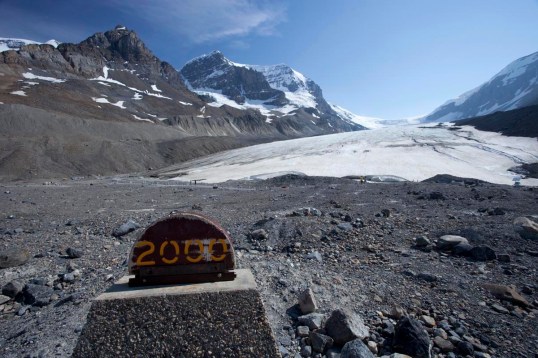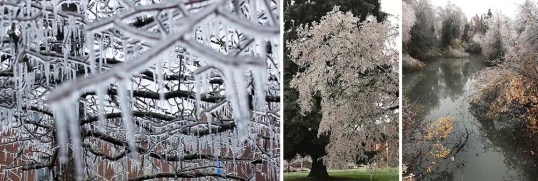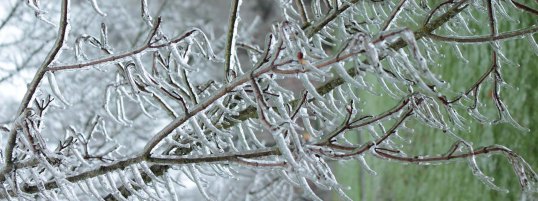
Crashing waves at Heceta Head, Oregon
You can’t avoid thinking about erosion while standing on one of Oregon’s rocky headlands. The waves keep coming, one after another, each crashing repeatedly against the same rock. Impossibly, the rock appears unmoved and unchanged. How can it not erode?
The answer, of course, is that headlands do erode, quickly, but on a geologic time scale. We just miss out because we live on the much shorter human time scale. And the erosion belongs to a cycle in which coastal uplift causes eroded and flattened headlands to rise and become headlands once again, all subject to more ongoing erosion and uplift.
Wave energy is most intense at headlands because the incoming wave typically feels the ocean bottom near the headland first, which causes the wave to refract. As shown in the aerial photo below, this refraction focuses the wave energy on the headland.

Wave refraction causes wave energy to focus on the headland. Arrows are perpendicular to wave fronts.
As you can see in the next few images, headlands don’t erode evenly. They erode irregularly, as the waves exploit any kind of weakness in the rocks such as faults and fractures, or if they’re sedimentary, bedding surfaces. The products of this erosion are as beautiful as they are interesting: sea stacks, sea arches, sea caves… The list goes on and on.

Aerial view of Heceta Head, Oregon.
From the above photo, you can see that sea stacks are simply the leftover remains of a headland as it retreats from erosion. That’s a critical point, because some sea stacks, especially the one with the arch in the photo below, are a long way from today’s coastline.

Sea stacks and sea arch, southern Oregon
Those rocks, 1/4 to a 1/2 mile away used to be a part of the coastline? The land used to be way out there? YES!!! For me, that’s one of the very coolest things about sea stacks –they so demonstrate the constant change taking place through erosion.
Taken to its extreme, erosion renders headlands into wave-cut platforms, such as the one below at Sunset Bay. Being in the intertidal zone, these platforms make great places for tide-pooling–and ironically, for people-watching too. Geologically, they form important markers because they’re both flat and form at sea level. When found at higher elevations, they indicate uplift.

Wave-cut bench at Sunset Bay, Oregon
In fact, looking carefully at the photo above, you can see a flat surface on the other side of the bay. It’s an uplifted wave-cut platform! Called a marine terrace, it’s covered by gravel and sand originally deposited in the intertidal zone. Those deposits rest on bedrock that, at an earlier time, was also flattened by the waves. The photo below shows a better view of this terrace from the other side.

Breaking wave at Shore Acres State Park, Oregon. Tree-covered flat surface in the background is an uplifted marine terrace.
These uplifted marine terraces can be found up and down Oregon’s coastline. Researchers recognize several different levels, the oldest being those uplifted to highest elevations. The one in the photo above at Shore Acres State Park is called the Whiskey Run Terrace and formed about 80,000 years ago. You can see a similar-aged terrace below as the flat surface beneath the lighthouse at Cape Blanco, Oregon’s westernmost point. An older, higher terrace forms the grass-covered flat area on the right side of the photo.

Cape Blanco, Oregon looking NE. The flat surface beneath the lighthouse is the ~80,000 year-old Cape Blanco Terrace, probably equivalent to the Whiskey Run Terrace at Shore Acres; the flat area on the right side of the photo is the higher Pioneer Terrace, formed ~105,000 years ago.
Researchers take the approximate ages of the terraces and their elevations to calculate approximate rates of uplift. In this area, Kelsey (1990) estimated a rate of between 4-12 inches of uplift every 1000 years. That might seem slow, but over hundreds of thousands of years, it can accomplish a great deal.
And look! The uplifted terraces? They’re on headlands! Of course, because they’ve been uplifted! And the headlands are now eroding into sea stacks and then platforms –to be uplifted in the future and preserved as marine terraces that sit on top headlands. And on and on, as long as the coastline continues rising.

Blowhole near Yachats, Oregon. Incoming wave funnels up a channel eroded along a fracture and explodes upwards on reaching the end.
Some links and references:
Kelsey, H.M., 1990, Late Quaternary deformation of marine terraces of the Cascadia Subduction Zone near Cape Blanco, Oregon: Tectonics, v. 9, p. 983-1014. (Detailed study of Cape Blanco, including uplift rates).
Miller, M., 2014, Roadside Geology of Oregon, Mountain Press, Missoula, 386p. (General reference which details the concepts and includes several of the photos used here).
Earth Science Photographs: free downloads for Instructors —or anybody! (my webpage)
Posted in
aerial geology,
aerial photography,
Coastal uplift,
Geologic Time,
Geology,
Geology, Geologic Time,
geophotography,
photography,
science and tagged
Cape Blanco,
Coastal uplift,
coastlines,
Earth Science,
erosion,
geologic time,
geology,
geology photos,
headlands,
Heceta Head,
landscape,
lighthouses,
marine terrace,
nature,
Oregon,
Pacific Coast,
photography,
plate tectonics,
science,
sea arch,
Sea stacks,
Sunset Bay,
tectonics,
tectonism,
uplift,
USA,
wave refraction,
wave-cut platform,
waves,
Yachats




























